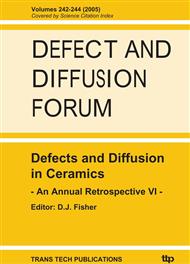p.9
p.17
p.27
p.43
p.65
p.77
p.95
p.107
p.115
Transport and Electrochemical Properties of LiyNixMn2-xO4 (0.1 ≤ x ≤ 0.5) Cathode Materials
Abstract:
In this paper structural, electrical, electrochemical and thermal (DSC) characterization of series of manganese spinel samples with manganese substituted to different degree (x = 0 – 0.5) with nickel are presented. The conductivity and thermoelectric power measurements were performed in wide temperature range also versus oxygen partial pressure and for deintercalated samples. Electrochemical studies of these cathode materials were conducted in Li / Li+ / LiyNixMn2−xO4 type cells. Substitution of manganese with nickel causes disappearance of the phase transition characteristic of LiMn2O4 spinel. Studies of electrical properties reveal that Ni ions do not participate in charge transport at low temperatures. In the charge curves of Li / Li+/ LiyNixMn2−xO4 cells there are two visible plateaux, separated with distinct potential jump (~0.5V), which position on Li content perfectly matches the Mn3+ content in the doped cathode material. The lower plateau is related to the Mn3+ → Mn4+ oxidation, while the next of higher voltage, of the dopant Ni2+ → Ni4+ oxidation. The schematic diagrams of relative Mn – Ni electronic levels alignment are proposed.
Info:
Periodical:
Pages:
65-76
Citation:
Online since:
September 2005
Authors:
Keywords:
Price:
Сopyright:
© 2005 Trans Tech Publications Ltd. All Rights Reserved
Share:
Citation:


